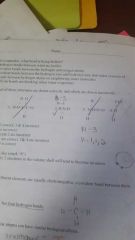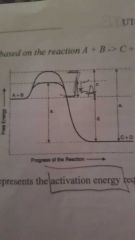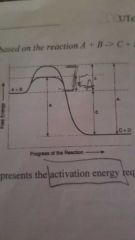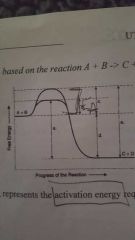![]()
![]()
![]()
Use LEFT and RIGHT arrow keys to navigate between flashcards;
Use UP and DOWN arrow keys to flip the card;
H to show hint;
A reads text to speech;
130 Cards in this Set
- Front
- Back
|
(1.1) Since the mold inhibits the growth of bacteria, something it produces may be effective as protection against bacteria that are toxic to mice. This is an example of |
Forming a hypothesis |
|
|
(1.2) The survival of infected mice treated with extracts of the mold was compared to infected mice that received a commonly used medication as a control. This is an example of |
Testing |
|
|
(1.3) A researcher notices that bacterial growth is inhibited in cultures that are contaminated by a green mold. This is an example of |
Observation |
|
|
(1.4) If labratory mice are injected with an extract of the mold that inhibits bacterial growth in cultures, then those mice should survive being infected by the same bacteria. This is an example of |
Making a prediction |
|
|
(1.5) The results from studies with mice lend support to the notion that something produced by the mold effectively protects mice from certain bacterial infections. This is an example of |
Concluding if hypothesis is supported by test results |
|
|
(1.6) All living things have the following properties EXCEPT for one, which is... |
They have a nucleus containing chromosones |
|
|
(1.7) Two feline families belonging to the same class mammalia must also belong to the same |
Phylum |
|
|
(1.8) In terms of biological hierarchy, organisms that are classified in different phyla could be classified in the same class. |
False |
|
|
(1.9) All cells have ribosomes and a cell membrane |
True |
|
|
(1.10) The influenza virus is one example of the smallest biological unit of life |
False |
|
|
(1.11) Atoms share electrons in a _____ chemical bond. |
Covalent |
|
|
(1.12) The drain cleaner Liquid Plumber contains the base NaOH as the main ingredient in solution. The approximate pH of this solution would be |
9.5 |
|
|
(1.13) The atomic number of chlorine is 17. The number of valence electrons a chlorine atom has is |
7 |
|
|
(1.14) According to the octet rule, atoms with eight electrons in their valence shell tend to |
Be particularly stable and inert |
|
|
(1.15) A classmate doesn't understand what a polar molecule is. You explain it has |
A slightly negative side and a slightly positive side |
|
|
(1.16) When water evaporates, what bond is being broken? |
The hydrogen bonds between water molecules |
|
|
(1.17) Identify which of these structures are drawn correctly and which are drawn incorrectly |

All except 2 are incorrect |
|
|
(1.18) An atom with only 2 electrons in the valence shell will tend to become an anion |
False |
|
|
(1.19) If two atoms of different elements are equally electronegative, a covalent bond between them will be non-polar |
True |
|
|
(1.20) The molecule CH4 has four hydrogen bonds |
False |
|
|
(1.21) Molecules with similar shapes can have similar biological effects |
True |
|
|
(1.22) Which functional group is characteristic of pyridoxal (a B vitamin) |
Aldehyde |
|
|
(1.23) Which of these are classified as a carbonyl? |
Aldehyde and ketone |
|
|
(1.24) Which of these carbohydrates has a ratio of carbon:hydrogen:oxygen of 1:2:1? |
Pentose, glucose, and fructose |
|
|
(1.25) Which of the following is a dehydration type of reaction? |
2 glucose molecules --> 1 Maltose and water |
|
|
(1.26) How molecules of water would be needed to completely hydrolyze a polysaccharide that consist of 50 Monosaccharides? |
49 |
|
|
(1.27) The functional groups characteristic of carbohydrates include |
Aldehyde, ketone, and alcohol groups |
|
|
(1.28) The "fiber" referenced in food labels is a reference to the content that is |
Cellulose |
|
|
(1.29) The structural function of cellulose is due to ____ the polysaccharide chains that make up cellulose |
Hydrogen bonding between |
|
|
(1.30) Lipid Types of molecules are characteristically |
Non-polar |
|
|
(1.31) Which functional group(s) is/are part of a fatty acid molecule having a formula of C16H32O2? |
Acid |
|
|
*(1.32) Which functional group(s) is/are joined by dehydration in forming a fat molecule? |
Acid and alcohol group |
|
|
(1.33) For any given fatty Acid, which structure would be characteristic of animal fat (lard, true butter)? |
Saturated |
|
|
(1.34) Hydrogenation is a process that |
Converts unsaturated fat to saturated fat |
|
|
(1.35) Which of these will have a double covalent bond in its molecular structure? |
An omega fatty acid |
|
|
(2.1) Proteins are an essential component of a healthy diet for humans and other animals. Their most common function is to serve as |
Basic-building blocks for making complex molecules like enzymes |
|
|
(2.2) The primary structure of proteins is often described as amino acids connected like beads on a string. In this same vein, and which of the following images best describes a protein's secondary structure? |
A corkscrew |
|
|
(2.3) Plants growing in phosphate-deficient soil will have a hard time making |
Nucleotides |
|
|
(2.4) The bond linking one amino acid with another amino acid is a ____ bond |
Covalent (aka peptide) |
|
|
(2.5) What functional group(s) would be required for making amino acids? |
-COOH & -NH2 |
|
|
(2.6) The tertiary structure of a protein consists of a 1º and 2º structure bonded together with hydrogen bonds. |
False |
|
|
(2.7) The strength of peptide bonds is such that even if denaturing disrupts the hydrogen bonds of a protein's 2º structure, the peptide bonds will persist |
True |
|
|
(2.8) Hair curls are based on the strength of keratin proteins and amino acids that have -R groups that link together through peptide bonds. Hair straightening products decrease the number of peptide bonds. |
False |
|
|
(2.9) A prion is a harmful, disease-causing form of protein derived from what were once normal proteins |
True |
|
|
(2.10) The typical nucleic acid molecule consists of these elements |
CHONP |
|
|
(2.11) The basic functions of nucleic acids like DNA and RNA are |
Information storage and protein synthesis |
|
|
(2.12) Structurally, an intact DNA molecule consists of |
2 strands of polynucleotides |
|
|
(2.13) When DNA is denatured, the bonds that are broken are |
The hydrogen bonds between the parallel strands |
|
|
(2.14) A ten-unit polynucleotide strand of RNA would have how many nitrogenous bases? |
10 |
|
|
(2.15) Kwashiorker is a life-threatening and debilitating form of malnutrition. It's caused by |
A lack of protein in the diet |
|
|
(2.16) The transport of molecules across a membrane from an area of low concentration to the high of higher concentration of the same molecules will involve: |
Active transport |
|
|
(2.17) The ____ of phospholipids extend _____ the intracellular and extracellular fluid, and the ____ are directed ______ these watery fluids |
Hydrophillic heads, toward... Hydrophobic tails, away from |
|
|
(2.18) Which of the following should be able to diffuse freely through a cell membrane? |
CO2, N2, O2, and any small non-polar molecule with a neutral charge |
|
|
(2.19) The cell membrane is made up of |
Phospholipids, embedded proteins, and interspersed cholesterol molecules |
|
|
(2.20) The fluidity of a membrane is enhanced by |
Degree of unsaturated phospholipid content and cholesterol content |
|
|
(2.21) The cell junctions that respectively: 1. Maintain tissue form and strength 2. Allow the exchange of small molecules between adjacent cells 3. Exclude the passage of water between cells are: |
Anchoring, gap, and tight |
|
|
(2.22) A cell adapted to water in Lady Bird Lake and placed in the Gulf of Mexico will... |
Assuming the salinity of lakes is less than the Gulf and that all lakes have the same salinity... Lose volume |
|
|
(2.23) A cell adapted to water in Lady Bird Lake and placed in Lake Travis will... |
Assuming the salinity of lakes is less than the Gulf and that all lakes have the same salinity... Not change volume |
|
|
(2.24) A cell adapted to water of the Gulf of Mexico and placed in Lady Bird Lake will... |
Assuming the salinity of lakes is less than the Gulf and that all lakes have the same salinity... Gain volume |
|
|
(2.25) Which of the following statement(s) about the cell theory is/are correct? |
All living organisms are made up of one or more cells AND all cells arise from other, pre-existing cells |
|
|
(2.26) A structure common to both prokaryote and eukaryote cell types |
Phospholipid Bilayer cell membrane |
|
|
(2.27) Comparatively speaking, what is the typical size differences of prokaryote and eukaryote cells? |
Eukaryotes are about 10 times bigger than prokaryotes |
|
|
(2.28) Smooth endoplasmic reticulum (SER) functions include... |
Detoxifying drugs and poisons AND storage of calcium ions |
|
|
(2.29) This structure is an organelle that modifies proteins produced by RER |
The Golgi body |
|
|
(2.30) In which cell would you expect to find the most RER? |
A cell that secretes enzymes |
|
|
(2.31) In many eukaryotic cells, the ER makes up most of the membranes in the cell |
True |
|
|
(2.32) Tay Sachs disease is a hereditary disorder involving dysfunctional lysosomes |
True |
|
|
(2.33) When a protein like insulin is secreted by a cell, the process involved is known as endocytosis |
False |
|
|
(2.34) One function of the cytoskeleton is the anchoring of cell organelles |
True |
|
|
(2.35) A function of cilia is to increase the cell's surface area for better absorption |
False |
|
|
(3.1) Which of the following restates the 1st law of thermodynamics? |
The total amount of energy in the universe does not change |
|
|
(3.2) Which of the following has the greatest entropy? |
An old building upon being torn down |
|
|
(3.3) With regard to thermodynamics, what is meant by the term "a closed system" |
Neither energy nor matter can enter or leave the system |
|
|
(3.4) A non-spontaneous reaction occurs in a system moving toward equilibrium |
False |
|
|
(3.5) An endergonic reaction proceeds with a net output of energy |
False |
|
|
(3.6) Enzymes add energy to the reactions they catalyze |
False |
|
|
(3.7) Most enzymes are consumed by the reactions they catalyze |
False |
|

(3.8) Which of the following represents the activation energy required for the enzyme-catalyzed reaction? |
B |
|

(3.9) Which of the following represents the activation energy of the reaction in the absence of an enzyme? |
C |
|

(3.10) Which of the following represents the total free energy of the reaction? |
D |
|
|
*(3.11) Which of the following represents a summary of the photosynthesis reaction? |
CO2+ H2O+ light --> O2+ CH2O |
|
|
*(3.12) The actual production of O2 during photosynthesis takes place during the... |
Light Dependent reactions in the thylaloid membrane |
|
|
(3.13) A molecule of chlorophyll increases in potential energy |
When one of its electrons is boosted to a higher energy excited state by a photon of light |
|
|
*(3.14) Where and during what stage of photosynthesis is a carbohydrate molecule (CH2O) produced? |
In the stroma of the Calvin cycle |
|
|
*(3.15) Which of these statements regarding light-dependent reactions in chloroplasts is false? |
Generates O2 and H2O |
|
|
*(3.16) Which of these represents the essence of the respiration process? |
CH2O+ O2 --> CO2+ H2O + ATP |
|
|
*(3.17) The metabolic pathway that changes glucose to pyruvate acid is called ____ and occurs in the _____ |
Glycolysis; cytoplasm |
|
|
(3.18) In cellular respiration where do the oxygen atoms from molecular oxygen end up? |
In H2O |
|
|
(3.19) Which of these would not be a product of fermentation? |
O2 |
|
|
*(3.20) Which of these is produced by reactions of the Krebs Cycle of aerobic respiration? |
ATP, NADH, FADH2, & CO2 |
|
|
(3.21) Which sequence of the cell cycle is common to eukaryotes? |
G1 to S to G2 to M to cytokinesis |
|
|
(3.22) Prior to cell division, each chromosone replicates or duplicates its genetic material. The products are connected by a centromere and are called |
Sister chromatids |
|
|
(3.23) The stage of mitosis when chromosones are lined up in the mid-section of the cell |
Metaphase |
|
|
(3.24) Which of the following statements is NOT true of mitosis? |
The daughter cells are each haploid after cytokinesis |
|
|
(3.25) The number of chromosones in daughter cells produces by mitosis is 2X the number in the parent cell |
False |
|
|
*(3.26) If the amount of DNA in a gamete is X, then the amount in the G2 cell before meiosis is |
4X |
|
|
*(3.27) The homologous chromosones separate during |
Anaphase I |
|
|
(3.28) Chromatids separate during |
Anaphase II |
|
|
(3.29) The meiotic division most similar to the phases of mitosis is meiosis I |
False |
|
|
(3.30) Two haploid cells are produced at the end of meiosis I |
True |
|
|
*(4.1) Full induction of the lac operon occurs when |
Lactose levels are high and glucose levels are low |
|
|
*(4.2) The trp repressor blocks transcription of the trp operon when the repressor |
Binds to tryptophan |
|
|
(4.3) If a particular operon codes for the enzymes needed to make an essential amino acid and is regulated like the trp operon then |
The amino acid acts as a co-repressor |
|
|
(4.4) What occur if the repressor of an inducible operon were mutated so if could not bind the operator? |
Continuous transcription of the operon' s genes |
|
|
(4.5) For eukaryotes, which is the most common control point for gene expression? |
Transcription |
|
|
(4.6) Which of the following allows more than one type of protein to be produced from one gene? |
Alternative forms of RNA splicing |
|
|
(4.7) Which method of gene regulation is utilized by bacteria that is not used by eukaryotes? |
Operons |
|
|
(4.8) The polymerase chain reaction (PCR) |
Makes it possible to create huge numbers of copies of tiny pieces of DNA |
|
|
(4.9) Which of the following are always the same in every DNA nucleotide? |
The sugar and the phosphate group |
|
|
*(4.10) A vector is the term used to refer to a molecule that |
Is able to bind to and carry foreign DNA into cells |
|
|
*(4.11) Restriction enzymes are enzymes capable of |
Cutting a DNA molecule into fragments |
|
|
(4.12) A method which allows easy visualization of genetic modification in some experimental studies involves the use of |
Green Fluroscent protein (GFP) |
|
|
(4.13) The advantage of using DNA polymerases from thermophillic bacteria in PCR is that the DNA polymerases of these bacteria are not denatured by the high temps needed to denature the DNA |
True |
|
|
(4.14) Of the qualities necessary for a specific short tandem repeat to be an effective "marker" for identifying DNA samples, it must have multiple alleles in the population and a low mutation rate. |
True |
|
|
(4.15) A restriction enzyme denatures a DNA molecule by breaking the hydrogen bonds between the bases of the DNA nucleotides |
False |
|
|
(4.16) An autosome is |
Any chromosone other than the X or Y chromosones |
|
|
(4.17) An individual that is heterozygous for a certain trait has |
Pair of non-identical alleles |
|
|
(4.18) _____ describes when one gene influences the expression of a separate and different gene |
Epistasis |
|
|
(4.19) In a dihybrid cross between two plants, both heterozygous for height and flower color, about how many offspring would you expect to be short plant with blue flowers? Assume the dominant alleles result in tall plants and blue flowers; homozygous recessive alleles result in short plants with white flowers. |
3 out of 16 |
|
|
*(4.20) |
F |
|
|
*(4.21) |
F |
|
|
(4.22) If both parents are heterozygous (dominant and recessive alleles) for a trait, and they have 4 children |
The probability of any of the outcomes above is not absolute |
|
|
(4.23) If both parents are homozygous for a trait (meaning that BOTH parents are either homozygous dominant or homozygous recessive), and they have 4 children |
All the children will be homozygous like the parents |
|
|
(4.24) 2 adults with AB blood types have a child. What are the chances the child will have blood type A? B? AB? Or O? |
25%, 25%, 50%, 0% |
|
|
(4.25) If the recessive allele i should disappear from the population, what blood types would be in the population? |
A, B, & AB |
|
|
(4.26) Assume non-disjunction involving the X chromosone occurs during meiosis and produces 2 kinds of eggs, XX & O (no X chromosone). If normal sperm carrying the Y chromosone fertilize the 2 types, which genotypes are possible? |
YO & XXY |
|
|
(4.27) The odds of getting 2 homozygous dominant offspring from 2 heterozygous parents is 1/16 |
True |
|
|
(4.28) A test cross is when a heterozygous genome is mated with a homozygous dominant genome |
False |
|
|
(4.29) Though a son may not get an X chromosone from his father, the son could be a carrier of an X linked recessive allele |
False |
|
|
(4.30) A father that has a dominant autosomal allele will only pass it on to his daughters |
False |

